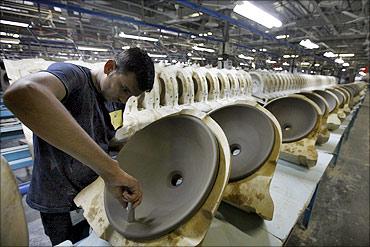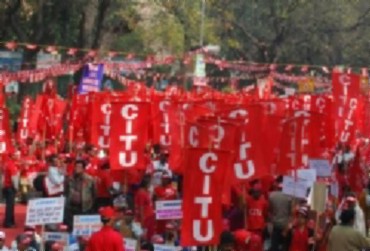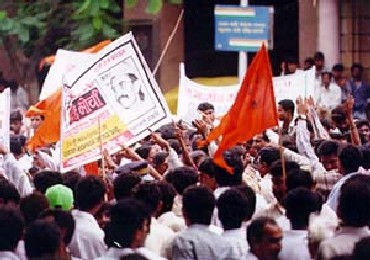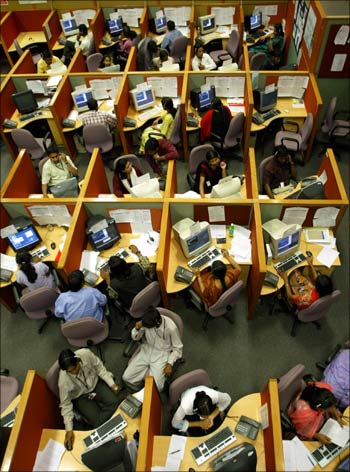 | « Back to article | Print this article |
More jobs? Make trade unions LESS relevant!
Manish Sabharwal, the chief executive officer of TeamLease is also one of the Steering Committee members for the 12th Plan at the Planning Commission.
TeamLease Services, started in 2002, has 75,000 employees in over 600 locations in India. It is India's leading temporary staffing company and provides a range of temporary and permanent manpower solutions to over 1,000 clients.
In this interview, Sabharwal talks about starting TeamLease and also the employment scene in India. . .
Did you always want to be an entrepreneur?
I started my first company straight out of my Business School at Wharton. That was in HR outsourcing (India Life), my final project in the Business School.
As an entrepreneur, you can create two kinds of companies, a baby and a dwarf. A baby may be small but it will grow, but a dwarf will remain the same.
In retrospect, I have had the privilege of creating both a baby and a dwarf. I sold the dwarf as it was not that large.
Click NEXT to read on . . .
More jobs? Make trade unions LESS relevant!
India Life which I started for HR outsourcing was interesting and it was doing well when we sold it to Hewitt Associates (an Illinois-based global HR consulting firm).
After that, I worked for some time for Hewitt, but I did not really enjoy the big company atmosphere.
When I and my friend Ashok Reddy sat down to discuss about the next company we were to start, we had three things in mind; fun, profitability and its being good for India.
When we sold India Life, we realised that there were five labour market transitions happening; farm to non-farm, rural to urban, unorganised to organised, and self employment to wage employment. So, we decided to start a staffing company.
Click NEXT to read on . . .
More jobs? Make trade unions LESS relevant!
How was it, starting a second enterprise?
Running a second venture is much easier. You have experienced it all the first time.
TeamLease scaled much faster as I got 37 people from India Life the day the anti-poaching term ended. It took 6 years to take India life from zero to Rs 40 crore (Rs 400 million) but in the same time, TeamLease went from zero to Rs 800 crore (Rs 80 billion)!
Till earlier this year, we didn't take an external investor for TeamLease; we ran it with the Rs 10 crore (Rs 100 million) we got by selling India Life.
Why a staffing company?
It was a wide open opportunity. Indian labour markets are so inefficient. There are so many opportunities but employers can't find employees and employees can't find employers.
We hire the employees and rent them out. We create another layer in the employee-employer market.
Click NEXT to read on . . .
More jobs? Make trade unions LESS relevant!
Is it for the organised sector or the unorganised sector that you supply employees?
It is an unorganised supply to organised demand. Almost 92 per cent of India's labour market is in the unorganised sector, which is a tragedy.
Any particular sector you wanted to cater to?
About 50 per cent of our supply is to sales. Sales in financial services, agro-chemicals, etc. are the fields. India as a market is expanding. Domestic demand is fast increasing.
In 2004 when you started TeamLease, how was the labour market in India?
It hasn't changed much. Labour market, unfortunately is an unfinished frontier of Indian reforms.
Today, the labour market is not only where it was in 2004 but where it was in 1991; 92 per cent in informal employment, 12 per cent in manufacturing, 50 per cent self employed and 58 per cent in agriculture.
This is exactly where it was in 1991. That is one of the tragedies of economic reforms; that they were not able to transform the labour market the way they have transformed the economy.
Click NEXT to read on . . .
More jobs? Make trade unions LESS relevant!
India's economic reforms are not about goofy rich guys buying Mercedes cars or Gucci bags. It's about giving opportunity to people.
What could be the reason?
There are many reasons but the major one is that labour laws have not been changed. The labour laws were written by the British. They encourage unorganised employment, capital substitution of labour, corruption, etc.
The laws are protected by the trade unions and they constitute only 8 per cent of India's labour force. They are a small vocal minority which has positioned its self-interest as national interest. They have blocked any reform of labour laws.
Job preservation is not job creation. Job creation is more important to India.
Click NEXT to read on . . .
More jobs? Make trade unions LESS relevant!
India's demographic divide is such that 1 million people will have to join the labour force every month in the next 20 years. Singapore has added this in every quarter. Every year, we add an Australia to our population.
It is said that after liberalisation, job creation has been taking place in India...
A lot of job creation has taken place but it has been taking place in the unorganised sector. Because of the labour laws, all the job creation is taking place in the informal sector, which is wrong.
Policy needs to recognise like the President of Peru said, that informal employment is the slavery of the 21st century. We should provide health and safety and give minimum wages.
Click NEXT to read on . . .
More jobs? Make trade unions LESS relevant!
Trade unions have made employment, a marriage without divorce. If you hire somebody, you can't fire them ever.
Trade unions are single-handedly responsible for India's job-creation happening in the unorganised sector. They are small but organised and powerful.
Political courage is not there to change the labour laws. Both politicisation of trade unions and criminalisation of politics are dangerous.
Trade unions have to become much less relevant to India's future if we have to recognise that job-creation is more important than job preservation.
You said trade unions are no longer relevant. Has the new economy created by liberalisation made them irrelevant?
They have become less relevant all over the world. Employment contract is changing. It is no longer lifetime employment. There are broader changes in the world of work.
Young people view a company as a platform to grow as a professional. Trade unions have very little to offer to young employees.
Click NEXT to read on . . .
More jobs? Make trade unions LESS relevant!
Who will be benefited by the change in the job scene?
All the young people. Youth unemployment and unemployability is higher even today. For massive job creation, you need to rewrite the labour laws.
In which sector do you see massive job creation?
IT is doing well. The fastest growing sectors will be the financial sector, telecom, retail, hospitality and healthcare.
Hopefully, one day we will recognise manufacturing. Only 12 per cent of India works in manufacturing. But for India to become the workshop of the world, we have a unique window here.
The Chinese wages have gone up substantially. So we have an opportunity in manufacturing. It will only be leveraged if we fix our labour laws and provide better infrastructure.
Click NEXT to read on . . .
More jobs? Make trade unions LESS relevant!
How do you define India's labour market and the labour force?
There are 440 million people. About 92 per cent of them are in the informal sector, and 50 per cent of the labour force suffers from some degree of skill deprivation.
It is due to a combination of the school education system and the training system. Supply and demand have become parallel universes. Agriculture does not need 58 per cent of our population.
You are into temporary staffing. How do you define your workforce?
We have 75,000 employees in 800 cities across the country. 50 per cent are graduates. Average age is around 23. Salaries we offer are above Rs 9,000.
We have 400-500 recruiters and we have 1400 corporate customers who recruit from us by giving us open positions at different locations. People for us are inventory.
Click NEXT to read on . . .
More jobs? Make trade unions LESS relevant!
Do you train the people?
We used to, for five years. Last year we bought a company called Indian Institute of Job Training which has 150 training centres across the country. We just got a license to set up TeamLease University which is India's first vocational university. We are setting up 22 community colleges.
We deal with 5 lakh (500,000) people. We have hired somebody every five minutes for the last five years. And we hired only 5 per cent of the kids who came to us for a job. We have 10,000 jobs everyday which we cannot fill. Unemployability is a bigger problem than unemployment.
I am at the agony and ecstasy of India's labour market. The ecstasy is obvious. I have a Telecom client shouting for 500 sales people whereas I had a job mela in Jaipur where 35,000 people showed up in one day.
Click NEXT to read on . . .
More jobs? Make trade unions LESS relevant!
Today, we see a huge migration of labour from Bihar, Jharkhand and West Bengal to the south. How do explain this?
In the next 25 years, 45 per cent of GDP growth will be in the south and west India with only 5 per cent of population growth there. 45 per cent the population growth will be in Uttar Pradesh, Bihar, Madhya Pradesh, etc, but they will contribute only 5 per cent of GDP. It is interesting to see whether we are going to see massive migration or will we create jobs there?
Our training institute has larger presence in the north and the east but the recruiting and client base are in the south and west of India. It will be like this: supply will be from the north and east and demand will be in the south and west.
At present which states have the largest demand for workforce?
Maharashtra, Gujarat, Andhra Pradesh, Tamil Nadu and Karnataka.
You say you are a temporary staffing company...
Yes, we are a temporary staffing company. Because we give work for 3months, 6 months, 9 months or 12 months.
In 2005, you said, by 2012, 25 per cent of world's workforce would be Indians. It is 2011 now, what is your opinion now?
We are already 20 per cent of the world's work force, and in another 2 years, 25 per cent of the world's new workers will be Indians.
One in four of the world's new workers with come from India. 12 million people will join the labour force every year.










